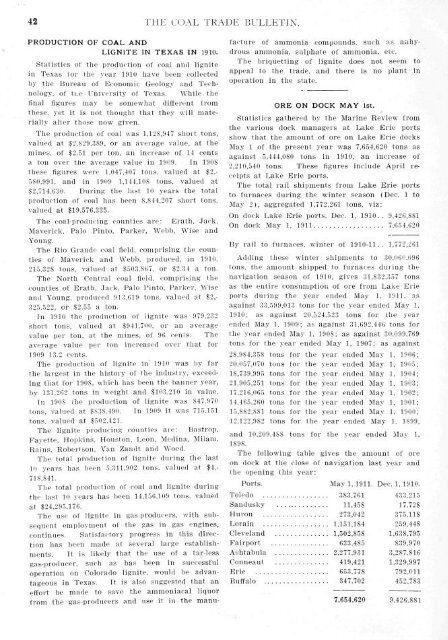u,.:- • - Clpdigital.org
u,.:- • - Clpdigital.org
u,.:- • - Clpdigital.org
Create successful ePaper yourself
Turn your PDF publications into a flip-book with our unique Google optimized e-Paper software.
42 THE C( )AL TRADE BULLETIN.<br />
PRODUCTION OF COAL AND<br />
LIGNITE IN TEXAS IN 1910.<br />
Statistics of the production of coal and lignite<br />
in Texas lor the year 1910 have been collected<br />
by the Bureau of Economic Geology and Tech<br />
nology, of tne University of Texas. While the<br />
final figures may be somewhat different from<br />
these, yet it is not thought that they will materially<br />
alter those now given.<br />
The production of coal was 1,128,947 short tons,<br />
valued at $2,S29,3S9, or an average value, at the<br />
mines', of $2.51 per ton, an increase of 14 cents<br />
a ton over the average value in 1909. In 1908<br />
these figures were 1,047,407 tons, valued at $2,-<br />
580,991. and in 1909 1,144.108 tons, valued at<br />
$2,714,630. During the last lo years the total<br />
production of coal has been 8.844,207 short tons,<br />
valued at $19,576,335.<br />
The coal-producing counties are: Erath, Jack,<br />
Maverick, Palo Pinto, Parker, Webb, Wise and<br />
Young.<br />
The Rio Grande coal field, comprising the counties<br />
of Maverick and Webb, produced, in 1910.<br />
215,328 tons, valued at $503.S67. or $2.34 a ton.<br />
The North Central coal field, comprising the<br />
counties of Erath, Jack, Palo Pinto, Parker, Wise<br />
and Young, produced 913.619 tons, valued at $2,-<br />
325.522, or $2.55 a ton.<br />
In 1910 the iiroduction of lignite was 979,232<br />
short tons, valued at $941,70(1. or an average<br />
value per ton, at the mines, of 96 cenls. The<br />
average value per ton increased over that for<br />
1909 13.2 cents.<br />
The production of lignite in 1910 was by far<br />
the largest in the history of the industry, exceed<br />
ing that for 1908, wdiich has been the banner year,<br />
by 131.262 tons in weight and $103,210 in value.<br />
In 1908 the production of lignite was 847,970<br />
Ions, valued at $S38.490. In 1909 it was 715.151<br />
tons, valued at $502,421.<br />
The lignite producing counties are: Bastrop.<br />
Fayette, Hopkins, Houston, Leon, Medina. Milam.<br />
Rains. Robertson. Van Zanrlt and Wood.<br />
The total production of lignite (luring the last<br />
10 years has been 5,311.902 tons, valued at $4,-<br />
718,841.<br />
The total iiroduction of coal and lignite during<br />
the last 10 years has been 14,156.109 tons, valued<br />
at $24,295,176.<br />
The use of lignite in gas-producers, with subsequent<br />
employment of the gas in gas engines,<br />
continues. Satisfactory progress in this direction<br />
has been made at several large establish<br />
ments. It is likely that the use of a tar-less<br />
gas-producer, such as has been in successful<br />
operation on Colorado lignite, would be advan<br />
tageous in Texas. It is also suggested that an<br />
effort be made to save the ammoniacal liquor<br />
from the gas-producers and use it in the manu<br />
facture of ammonia compounds, such as anhy<br />
drous ammonia, sulphate of ammonia, etc.<br />
The briquetting of lignite does not seem to<br />
appeal to the trade, and there is no plant in<br />
operation in the state.<br />
ORE ON DOCK MAY lst.<br />
Statistics gathered by the Marine Review from<br />
the various dock managers at Lake Erie ports<br />
show that the amount of ore on Lake Erie docks<br />
May 1 of the present year was 7,654,620 tons as<br />
against 5.444,080 tons in 1910, an increase of<br />
"2,210,540 tons. These figures include April re<br />
ceipts at Lake Erie ports.<br />
The total rail shipments from Lake Erie ports<br />
to furnaces during the winter season (Dec. 1 to<br />
May 2), aggregated 1,772,261 tons, viz:<br />
On dock Lake Erie ports. Dec. 1, 1910.. 9,426,881<br />
On dock May 1, 1911 7,654,620<br />
By rail to furnaces, winter of 1910-11.. 1,772,261<br />
Adding these winter shipments to 30.060,096<br />
tons, the amount shipped to furnaces dining the<br />
navigation season of 1910, gives 31,832.357 tons<br />
as the entire consumption of ore from Lake Erie<br />
ports during the year ended May 1, 1911. as<br />
against 33,599,013 tons for the year ended May 1,<br />
1910; as against 20,524,523 tons for the year<br />
ended May 1. 1909; as against 31.692,446 tons for<br />
the year ended May 1, 190S; as against 3o.099.769<br />
tons for the year ended May 1, 1907; as against<br />
28.984,358 tons for the year ended May 1, 1906;<br />
20,057,070 tons for the year ended May 1, 1905;<br />
IS,739,995 tons for the year ended May 1. 1904;<br />
21,905,251 tons for the year ended May 1, 1903;<br />
17,216,065 tons for the year ended May 1, 1902;<br />
14,4 65.260 tons for the year ended May 1, 1901;<br />
15,882,S81 tons for the year ended May 1. 1900;<br />
12,122,982 tons for the year ended May 1. 1899,<br />
and 10.209,488 tons for the year ended May 1,<br />
1S98.<br />
The following table gives the amount of ore<br />
on dock at the close of navigation last year and<br />
the opening this year:<br />
Ports. May 1, 1911. Dec. 1, 1910.<br />
Toledo 3S3.761 433.215<br />
Sandusky 11.45S 17.728<br />
Huron 273,042 375.118<br />
Lorain 1.151,184 259,448<br />
Cleveland 1,502,858 1,638,795<br />
Fairport 633,485 S39.970<br />
Ashtabula 2,277,931 3,287.816<br />
Conneaut 419,421 1,329,997<br />
Erie 653.778 792,011<br />
Buffalo 347,702 452,783<br />
7,654,620 9,426.881
















